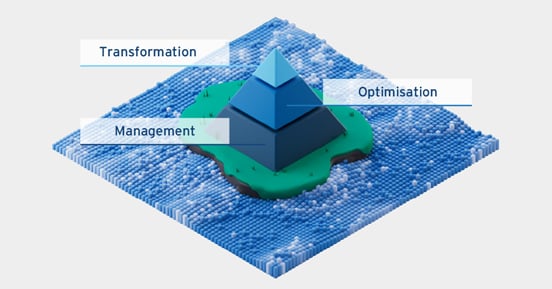Check before you chuck it: 7 asset disposal mistakes to avoid
Blogs and Articles
Is e-waste taking over your office? It's time to invest in IT asset disposal to free up space and earn some extra cash.

By: Michele Hope
Once legacy data has outlived its usefulness, what should you do with it: Repurpose it? Resell it? Recycle it? Destroy it? As it turns out, with IT asset disposal, you may be able to do all of the above.
What we're talking about is e-waste and a lot of it. This includes old computers, computer hardware, printers, fax machines, scanners and even consumer TVs and cell phones. E-waste, or waste from electronic devices, is the fastest growing waste stream in the world. It is estimated that 48.5M tons of e-waste was generated in 2018 according to the World Economic Forum. There are more data bearing devices per individual now than ever before. People have their computer, tablets, and smartphones. In addition, people have their smart watch as well as a whole host of ancillary devices that are part of their working and personal lives.
Given such sobering figures, it makes sense to keep track of your organization's IT asset disposition (ITAD) practices. Here are some mistakes to avoid—whether you're disposing of 1 or 1,000 items:
Once legacy data has outlived its usefulness, what should you do with it: Repurpose it? Resell it? Recycle it? Destroy it? As it turns out, with IT asset disposal, you may be able to do all of the above.
What we're talking about is e-waste and a lot of it. This includes old computers, computer hardware, printers, fax machines, scanners and even consumer TVs and cell phones. E-waste, or waste from electronic devices, is the fastest growing waste stream in the world. It is estimated that 48.5M tons of e-waste was generated in 2018 according to the World Economic Forum. There are more data bearing devices per individual now than ever before. People have their computer, tablets, and smartphones. In addition, people have their smart watch as well as a whole host of ancillary devices that are part of their working and personal lives.
Given such sobering figures, it makes sense to keep track of your organization's IT asset disposition (ITAD) practices. Here are some mistakes to avoid—whether you're disposing of 1 or 1,000 items:
- Not knowing where the asset ends up. Many third-party services offer to take and dispose of (or recycle) your IT assets. But, horror stories still exist with assets ending up in less-regulated, third-world countries or recycling work being performed by prison or child labor. How do you avoid such scenarios? Here's one way: See if your third-party service is certified with globally responsible programs, such as the recognized e-Stewards program.
- Not keeping the 'Six Ds' in mind to protect your data. Some organizations might assume basic deletion or overwriting of their disk data is enough to prevent sensitive data from falling into the wrong hands. Others might be in the habit of just removing the disk drives entirely before asset hand-off to a third party. Enterprises wanting to be sure their disk drives are wiped of sensitive data tend to subscribe to the following '6 Ds': Destroy data on disk drives according to the Department of Defense 5220.2-M standard. This involves a four-pass overwrite of each disk sector. Third-party services should follow such strict, overwrite methods. One caveat: Sensitive company data doesn't just exist on computer disk drives. It can also exist inside fax machines, copiers and company cell phones.
- DIY. Most organizations don't have sufficient resources or expertise to properly perform all aspects of IT asset disposition themselves. This is especially true for the complex recycling of electronic parts, such as circuit boards. Such methods include the safe isolation and disposition of a circuit board's toxic components as well as methods to extract and reuse the circuit board's high concentrations of heavy metals, such as copper, silver, gold and palladium.
- Not tracking or reporting assets. If you outsource IT asset disposition, it's important to track each asset and receive reports on its ultimate disposition or recycling. To minimize your company's risk and exposures, track how many items left your facility vs. how many were subsequently destroyed, repurposed or recycled. Not tracking assets at disposition can also be a sign of a bigger issue: Asset tracking shouldn't really begin at disposition. It should be part of your organization's overall IT asset management procedures. From the time an asset is acquired to its on-going use and ultimate disposition, asset lifecycle information can provide further cost savings. Does your company know how many laptops or computers it has?One company thought it owned 700 computers. A physical count, however, revealed 1,200 PCs in its possession.
- Being too quick to dispose of your assets. Many IT assets, even those no longer in working order, may still have good market value that can be recovered through refurbishment and resale. Remaining parts can be recycled according to approved recycling methods. There is a great deal of economic value in electronic waste. For example, there is 70 times more gold in a tonne of smartphones than in a tonne of gold ore according to ChinaDaily. The United Nations calculates that e-waste is worth 55 billion euros ($63.18 billion) annually, which is more than the GDP of most countries.
- Not squeezing the most out of equipment while you have it. We're not just talking about how much productive use you get out of a computer. Smart ITAD programs can further save companies money and gain tax benefits by depreciating and amortizing their older assets over time. They can also ensure IT assets are retired properly to minimize end-of-life penalties. Third-party experts can help devise plans for the greatest cost savings.
- Not knowing if you're compliant. There's a plethora of State and Federal regulations governing proper hardware disposal and data destruction. Such regulations surround everything from e-waste to data erasure and the protection of sensitive customer data. If you're in a highly regulated industry, you face still other requirements about the disposition of your data. According to the National Conference of State Legislators at least 35 states, D.C. and Puerto Rico have enacted laws that require either private or governmental entities or both to destroy, dispose, or otherwise make personal information unreadable or indecipherable.
Secure IT Asset Disposition: Yes, It's All About the Money
IT execs who worry about the cost of proper IT asset disposition should consider the cost of a data breach or waste-management violation. Here's how to weigh the options.While you can certainly go it alone when it comes to IT asset disposition, organizations most involved in reducing risk often rely on trusted third-party experts to ease the process. Learn more about how Iron Mountain can help.Related resources
View More Resources
Iron Mountain at a glance
We’re here to protect and elevate the power of your work — whatever it is, wherever it’s located, however it’s stored. Find out how we do it.
10 June 2024
 Premium
PremiumClosing gaps. Opening doors.
Many organisations, regardless of size or level of sophistication, believe they’re appropriately managing their information and data. Our experience shows that this is not always the case.
27 March 2024

Oceans of data. Seas of opportunity video
Let us help you classify, organise, secure, digitise, access and automate all your information—whatever it is, wherever it is, however it’s stored, allowing you to unlock its value to drive growth and secure your organisation’s future. A process that we call, information transformation. Watch the video to find out more.
21 February 2024